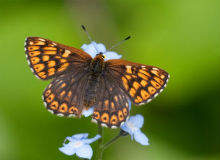

Last October, Chiltern Railways launched services between Oxford Parkway and London Marylebone, following an upgrade to 13km of track. Engineers are now installing 5km of two-track railway and remodelling the existing track layout between the new Oxford Parkway and the existing Oxford stations, in preparation for services from Oxford to London scheduled to start in December. New bridges are being built and track beds widened.
What makes this news more than just common railway engineering work is the announcement that purpose-built habitats are springing up beside the railway. "As well as providing a great new option for Oxford commuters and significant economic benefits to the city, this scheme is trying to tread as lightly as possible on the natural environment," explained Andy Milne, senior programme manager for Network Rail, earlier in May.
Newts, reptiles, badgers, bats and swallows are some of the species that are set to benefit. New ponds have also been created for great crested newts and these are being monitored to collect data after construction.
Additionally, ten artificial badger setts have been built along the route and planting plans have been developed to reinstate tree lines and linear flight paths used by commuting and roosting bats.
In total, there are 220 sites of special scientific interest (SSSI) on Network Rail-owned land and ecological surveys are carried out before project work starts.

US Tariffs are shifting - will you react or anticipate?
Don’t let policy changes catch you off guard. Stay proactive with real-time data and expert analysis.
By GlobalData"Railways have a real importance in terms of the wildlife near them," says Tanith Cook, senior ecological consultant for the Chiltern Railways project. "Often, the area near a railway can be a relatively untouched habitat, with a range of habitats and high biodiversity. They can act as wildlife corridors."
It is easy to see how railway infrastructure and wildlife, therefore, can become incompatible. At the extreme end of the spectrum, the recorded death toll of elephants struck by trains in India has soared to more than 100 over the past ten years.
A growing awareness
In the UK at least, these "wildlife corridors" – and their importance – are now playing a larger role in the discourse that surrounds railway construction. Cook believes that awareness within the industry is growing. "People are becoming more knowledgeable on what they should be doing and when they should be bringing in ecologists." This is borne out by the evidence.
As well as the Chiltern Railways project, volunteers from Network Rail’s ‘orange army’ joined forces with wildlife charity Butterfly Conservation in February to create a new habitat for the Duke of Burgundy butterfly colony on a patch of land adjacent to the London-Birmingham line.
Meanwhile, Crossrail, London’s newest railway, has transferred excavated material from construction sites to Wallasea Island, where the RSPB is using it to create a wildlife reserve. A total of 1,528 shipments have seen 3 million tonnes of material delivered. Speaking in April last year, RSPB chief executive Mike Clarke said: "Crossrail has demonstrated a bold and inspired vision for the way in which industry and conservation sectors can work together for the benefit of people and wildlife.
"As the pressures on our natural world continue to grow, it is crucial that we recognise a world-class economy and a world-class environment go hand in hand."
There’s also been a project over the River Cherwell in Banbury to improve the wildlife area and habitats for fish, birds and river plants, while some abandoned railways have been become places in which wildlife has flourished.
Even so, concerns remain. A booming rail industry is leading to more electrification of routes, Crossrail, and, of course, High Speed 2 (HS2), running from London to Birmingham.
Connecting protection with ambition
"I think in some cases we have to accept that it is not always possible to replace ‘like-for-like’ habitat in the same location, especially if we all want better rail links and train services," Cook admits. But, what is becoming more and more common is "biodiversity offsetting", which compensates for losses which cannot be avoided or mitigated within the rail corridor "by creating new habitats off site".
This is one way forward, as is encouraging "a new way of working and innovation on how to protect habitats on railway land", Cook says. Indeed, Network Rail is implementing a system that allows photos and descriptions, as well as GPS coordinates, of wildlife sightings to be uploaded to an app.
Nonetheless, some critics are voicing their displeasure, particularly on HS2’s potential impact.
A 2013 Independent on Sunday investigation claimed that up to 350 wildlife sites could be threatened by the high speed rail link. The London Wildlife Trust said "further landscape fragmentation will isolate species, leading to their decline", while MP Angela Smith claimed: "I support HS2, because we do need more capacity. But that shouldn’t come at a disproportionate price paid by wildlife."
Berks, Bucks & Oxon Wildlife Trust has also petitioned the HS2 Select Committee in recent years, working to reduce the impact on local wildlife. In response, HS2 spokesman Alastair Cowan says: "HS2 will build on best practice for environmental protection and we remain committed to our goal of seeking no net loss to biodiversity."
Cowan adds that wherever possible, the route has avoided ancient woodland and SSSI. "Our approach to ancient woodland is consistent with Natural England guidance and we have committed to creating new wooded areas, which will be managed and monitored for up to 50 years, as well as suitable mitigation and compensation measures for other habitats.
"An external ecology review group, including the Woodland Trust, will oversee monitoring results and make recommendations to ensure our ecological commitments are met," says Cowan.
The key, says Cook, is to start habitat preservation and reinstatement as early as possible, by bringing on board ecologists who are best placed to advise rail operators on how to minimise the damage to UK and European-protected species. Overall, "it is definitely improving", she believes.



